
I, personally, find the control of paper machines extremely interesting. As in many other plants, we generally find the vast majority of the regulatory controls on the paper machines are working extremely badly; and I am talking of literally dozens of machines that several colleagues and I have worked on between us. As I have stated in quite a few previous articles, it is really due to the innate skills of the operators that good quality paper is produced. However, if more paper companies were only prepared to invest some capital, manpower, and time in properly optimising their controls, the savings in costs, wastage, and in making less broke would be immense, let alone the potential improvement in quality.
The controls in a paper machine are very important as all the processes from the wet to the dry end follow on from each other. Therefore, if you can minimise control variance right from the beginning of the processes at the wet end, things will improve as the sheet moves down the machine. It is really important that virtually all the controls be set up properly. Even one control performing badly can have a ripple effect all the way down the line.
I came across a wonderful example of this recently, when working on optimising a paper machine in a South African paper plant. This was a strange problem that was occurring on the output of the blending chest. Figure 1 illustrates the typical control loops that may be encountered on a blending chest. Essentially, a blending chest is used to mix together the right quantities of the various pulp constituents that would be used in the manufacture of a particular type of paper.
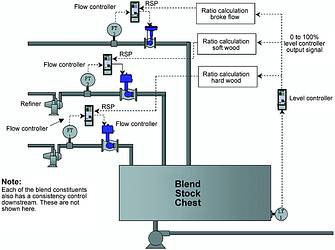
The master control on the chest is the level. Strangely enough this is the least important of the various loops from the control point of view. The actual level in the chest is in fact not critical at all. The only reason that a level control is there at all is to keep the level within reasonable limits, and to prevent it from going too high or too low.
The level is controlled by varying the cascaded inflows of the different pulp constituents in various ratios. Each of the individual constituent flows also usually has other controls upstream. For example, consistency, which can be roughly defined as the amount of wood fibres in the pulp stock, is controlled on each constituent by adding dilution water to that stock. (These controls are not shown in Figure 1). Also some or all of the various stocks may pass through refiners which are machines containing two large plates rotating in close proximity to each other, which effectively crush down coarser fibres.
Now the consistency controls, and the refiners in particular, do not operate well if the flow of pulp through them varies rapidly. The flows are set by the output of the master level control. As mentioned in previous articles, if you wish to have 'tight' level control it usually is necessary to have relatively high proportional gains in the level controller, which results in fairly large and possibly rapid movements in the output of the level controller. For this reason and as the blend chest level is not important, it is really imperative that the level be detuned to respond slowly, to avoid introducing rapid fluctuations in the stock constituents flows.
Whilst optimising the level of the blend chest it was noted that the level appeared to be cycling slightly and fairly slowly with a cycle period of approximately 2 min. The level controller was put into manual to stop the cycle but it still continued. As there was nothing else causing major inflows into the chest, it was concluded that the cycle must be caused by something further downstream from the chest, causing the flow coming out of the chest to cycle.
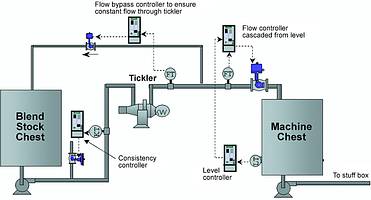
Figure 2 shows the configuration of the plant downstream from the blend chest. The stock is pumped out of the chest, and then passes through a final consistency control, after which it passes though a tickler (like a small refiner), and then on through a control valve before passing into the machine chest. This control valve is for controlling level in the machine chest, and is operated via a flow controller cascaded from the output of the machine chest level controller. In addition to all this, there is a small pipe after the tickler recirculating stock to the blend chest via a flow control valve. The purpose of this control is to ensure that a constant flow of stock passes through the tickler at all times. Thus, for example if the machine chest level controller got too high and the level control valve started closing, then the recirculation valve would in turn open further to keep a constant flow through the tickler.
The cycle seen on the blend chest level could of course have been caused by a cycle in any of these three control loops (viz consistency, recirculation flow, or level control cascade flow loop). The next step was to put all these three loops in manual as well as the inflow loops to the blend chest. To our amazement the cycle continued after all the loops were in manual, see Figure 3. The actual recording in the figure was taken from a pressure transmitter (not shown in drawings) that was on the output of the pump on the blend chest.
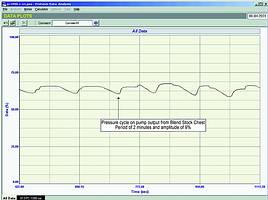
With all control loops in manual and no changes being made to any of the various controller's outputs it was very hard to understand what could cause the cycle. The effects of the cycle were of course extremely serious, as everything both downstream and upstream would respond to the cycle, when the controllers were in automatic, and good control at this stage of the paper making process is really critical. One most certainly does not want consistencies, blends, and refiner flows to move up and down in a 9% amplitude cycle every 2 min. The recording shown in Figure 4 is an excellent illustration showing how various other controls, including the blend chest level and the constituent stock inflows were following the cycle.
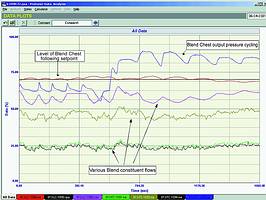
It was initially concluded that the problem must lie with the pump on the output of the blend chest, even though it was difficult to visualise what could cause a pump to exhibit such a strange phenomenon. As nothing could be done about this whilst the plant was running, it was decided to carry on optimising and tuning the loops leading up to the machine chest, until such time as the plant was stopped and the pump could be opened up and inspected.
Whilst performing the tests to optimise the machine chest level control system, it was noted that some very strange things happened whenever the valve was moved, with the flow seeming to vary all over the place. On physically examining the valve it was found that there were problems with it, and the valve was moving around slowly even when the controller was in manual. This then was the cause of the cycle. This is something really unexpected and extremely hard to uncover. It is actually very difficult to see a valve stem moving slowly over a small range. One actually needs to attach a stem position transmitter to be able to examine it properly.
It is also extremely rare to find a valve that is unstable and moving around with a constant input signal. In the few previous cases where I have encountered such valves, the movements were either random (sometimes caused by too low an air supply pressure to the valve/positioner combination), or else cyclic with a relatively short period (usually some instability in the positioner). I have never seen something of this nature before, but it certainly created havoc in a critical area in the process.
It was coincidental that when optimising one of the blend flow input loops, we encountered another unstable positioner. In this case the valve was cycling with a relatively much shorter period. The open loop test where this was discovered is illustrated in Figure 5. It shows that as the valve opens in response to step changes on the PD (controller output) signal the flow increases but once it got over 30%, a cycle appeared on the flow signal, the amplitude of which increased the further the valve opened. Another thing to note from the test is that the valve has nonlinear installed characteristics, which can be seen from the fact that on each movement of the PD (which was changed with equal steps), the increases in the size of the steps of flow decreased a little on each subsequent step.
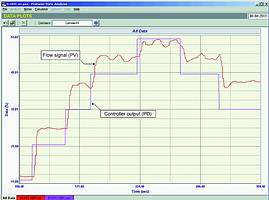
Another relatively serious control problem was also encountered on another of the flow loops of the pulp stock constituents, which is shown in Figure 6. In this case it was found that the maximum flow that could be attained by the flow loop was only 20% of the maximum scale and when the PD was below 30%. Once the PD moved above this point no further increase in flow was possible. An examination of the physical layout of the process showed that the flow line joined into another flow line at a point where the pressure in the second line was too high to allow much inflow from the joining line. It was suggested that the pipe carrying the pulp be extended directly to the blend chest.
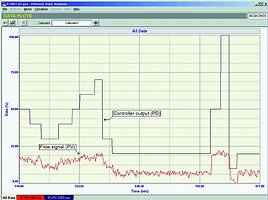
Apart from these problems it is interesting to note that not one of the loops we worked on was working efficiently in automatic. Some of the magnetic flowmeters had filters on of a minute or more (which is unbelievable). Most of the flow loops were so badly detuned that after optimisation, response times were improved by an average of about 200 times, and in one noteworthy case, over 2000 times!
The really interesting thing about all this is that until we started this work, the production people had no idea of the existence of these serious problems, and of the state of their controls, and as mentioned in the first paragraph of this article this is pretty common on most paper machines we work on, and in many other types of plants as well.
I firmly believe that it would pay large processing plants hundreds of times over, to seriously consider introducing an optimisation programme, which should be treated as a separate and important discipline.
Michael Brown Control Engineering
(011) 486 0567
Michael Brown is a specialist in control loop optimisation, with many years of experience in process control instrumentation. His main activities are consulting, and teaching practical control loop analysis and optimisation. He gives training courses that can be held in clients' plants, where students can have the added benefit of practising on live loops. His work takes him to plants all over South Africa, and also to other countries.

© Technews Publishing (Pty) Ltd | All Rights Reserved